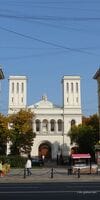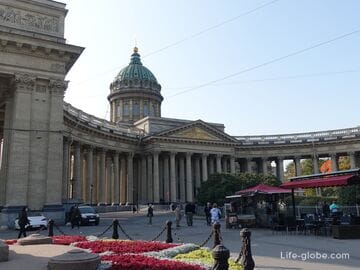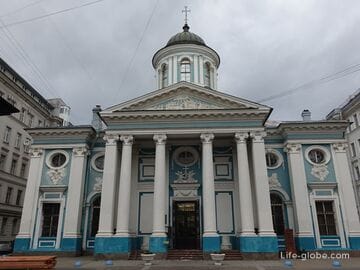PetrikircheThe Lutheran Church of Saints Peter and Paul (Petrikirche, German: Petrikirche) in St. Petersburg, is the largest Evangelical Lutheran church in Russia.
The church of Saints Peter and Paul hosts religious services, guided tours, including the catacombs of the Petrikirche, exhibitions and cultural events-mainly classical music concerts. The church has organs.
The Church of Peter and Paul is located in the center of St. Petersburg, between Bolshaya Konyushennaya and Malaya Konyushennaya streets, on Nevsky Prospekt - one of the most visited and beautiful streets of the city.
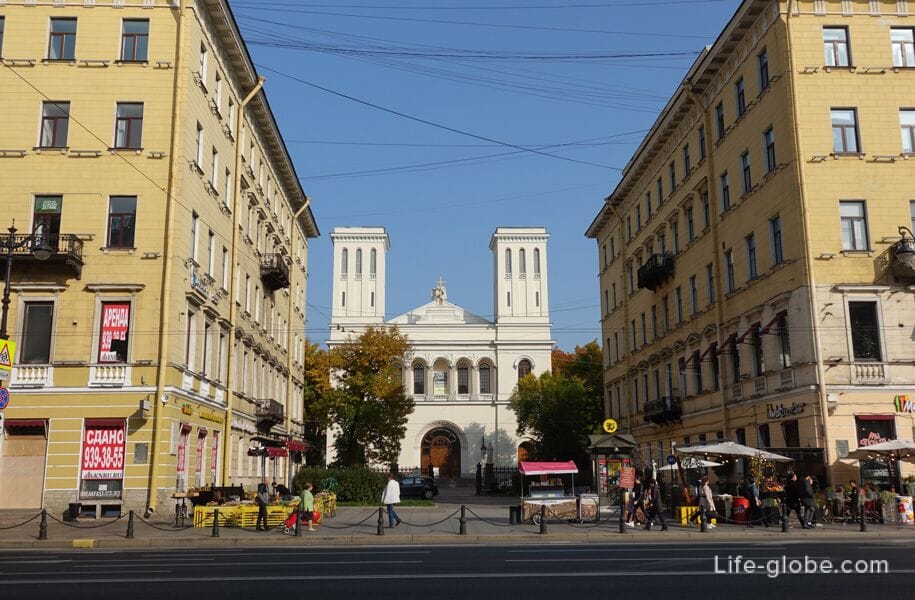
The history of the church dates back to the "Petrine times", when in 1727 Peter II gave the German Lutheran community a plot of land in this place, for the construction of a shrine, a parsonage and a school.
The first building of the church was laid on June 29, 1728 - the day of the Holy Apostles Peter and Paul. Hence the name, however, in the future, more and more often only the name of St. Peter is used – the church of St. Peter.
The church, built of brick with a small wooden tower, in the so-called "Peter's Baroque" style, was consecrated in 1730.
The second and current building of the church, when the first fell into disrepair and was demolished, was built in the period from 1833 to 1838 by the architect and artist Alexander Pavlovich Bryullov.
Subsequently, the facades and interiors of the church underwent restorations and artistic additions, including in 1895-1897, the interior of the church was radically changed by the architect Maximilian Mesmacher.
The decline of the church and the community occurred in the post-revolutionary period - after the October Revolution of 1917, many parishioners of the church emigrated from the city, but despite this, the Petrikirche worked until the end of 1937, when it was closed. In the same year, 1937, pastors Paul and Bruno Reichert were arrested and shot in 1938.
Subsequently, the church building was used for various purposes, including as warehouses and a swimming pool, and in 1941-1945, military units were located in the church. The building was falling into disrepair; some items of decoration, which were of artistic value, were confiscated and transferred to museums (including The Hermitage and The Russian Museum), while other valuable property was irretrievably spent.
In 1993, the church building was officially returned to the faithful. The exterior of the building was generally well preserved, but the interior left much to be desired. In the future, large-scale and long-term restoration work was carried out.
Today, the Petrikirche is a functioning Lutheran church. It has classic features with two symmetrical square towers, an arched portal (entrance) and windows. At the level of the second tier of the facade of the church is an open arcade with high reliefs of the Evangelists.
The upper part of the main facade (parapet), facing Nevsky Prospekt (to the south), is decorated with a sculptural composition of an angel with a cross.
On the attic, the bronze lettering of the inscription "St. Petri" with gilding stands out.
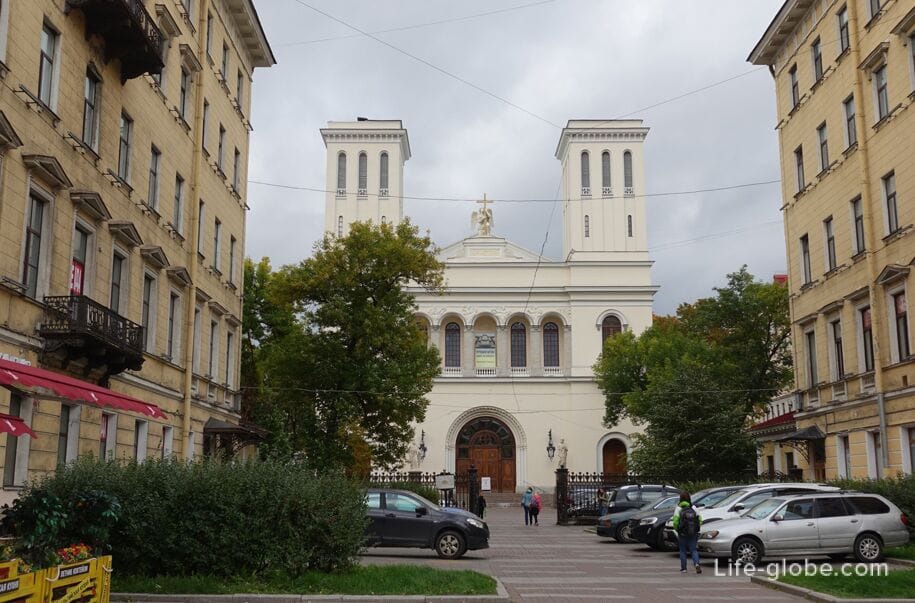
On both sides of the steps of the church, in front of the entrance, on high slender pedestals are placed marble statues of the Apostles Peter and Paul.
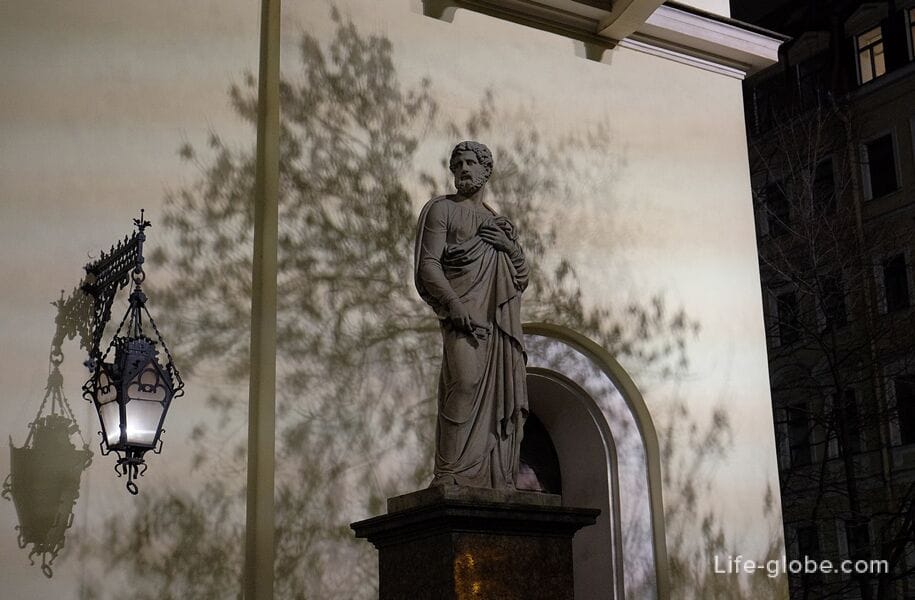
Interior decoration, exhibition and guided tours of Petrikirche
The interior of the Petrikirche is simple in execution. Here are the organs, conduct services, excursions and concerts.
There is a small exhibition on the ground floor, telling about the history of the church, and about the Lutheran community of St. Petersburg. The exhibition also features a variety of artifacts, including old liturgical books, utensils and reproductions of the Petrikirche stained glass windows, the originals of which are now stored in the Hermitage's vaults.
Two bronze models are also of interest in the exhibition. One of the models depicts the avenue of the lost organ, the other-the Petrikirche building, the model of which was created on the model of 1867, stored in the museum of the Russian Academy of Arts.
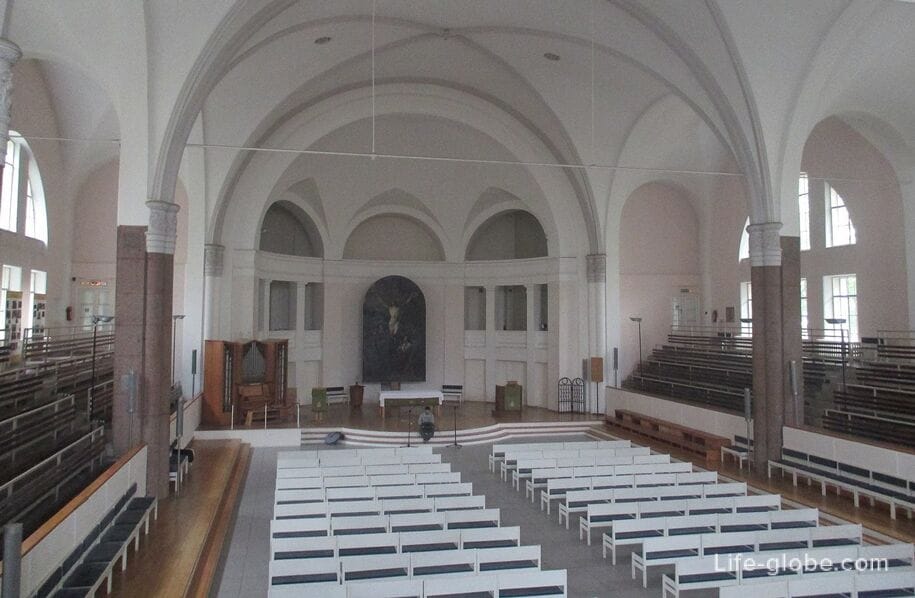
In 1997-1998, a small organ of the German company "G." was installed in the church. Steinmann", The instrument was made in 1958 and was originally located in the Church Conservatory in Herford, Germany.
The second organ of the church, made by the German company "Willi Peter", was brought in April 2017 from the Stockholm Church of St. Gertrude.
The solemn consecration of the organ with the participation of representatives of the government of St. Petersburg and the Federal Republic of Germany, as well as representatives of the Nordkirche (Evangelical Lutheran Church in Northern Germany) took place on September 28, 2017.
The church's organs are regularly played at services and concerts.
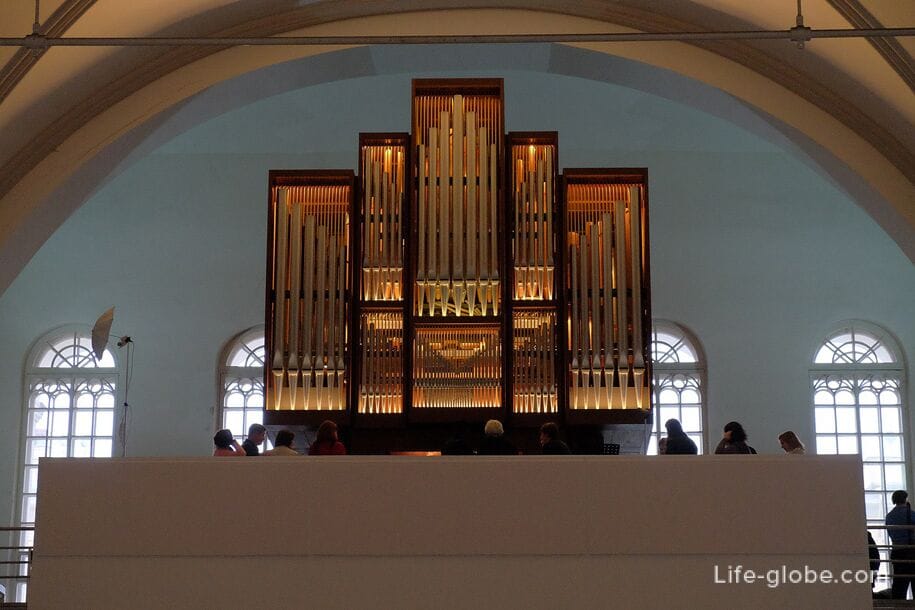
Catacombs of the Church of Saints Peter and Paul (Peterkirche Basement)
During the reconstruction of the 1990s, a new floor of the church appeared, which is now located 4 meters higher than the previous one and under it there are still rooms, including the bowl of the former pool - today these are the so-called catacombs (Peterkirche basements).
Guided tours of the catacombs are available. Exhibitions, installations, performances and productions are organized in the catacombs.
During a visit to the "Catacombs", you can see the basin of the pool, the basement surrounding it with the bases of granite pylons at the level of the old church hall; the original cross, which was once held by an angel over the entrance to the temple; as well as paintings with Christian symbols, made in 2007 by the American neo-expressionist artist Matt Lamb (Matt Lamb) together with students of art schools in St. Petersburg.
You can visit the catacombs with a guided tour, or freely, when visiting the events of the church.
On certain days, services and hours of prayer are held in the "Catacombs".
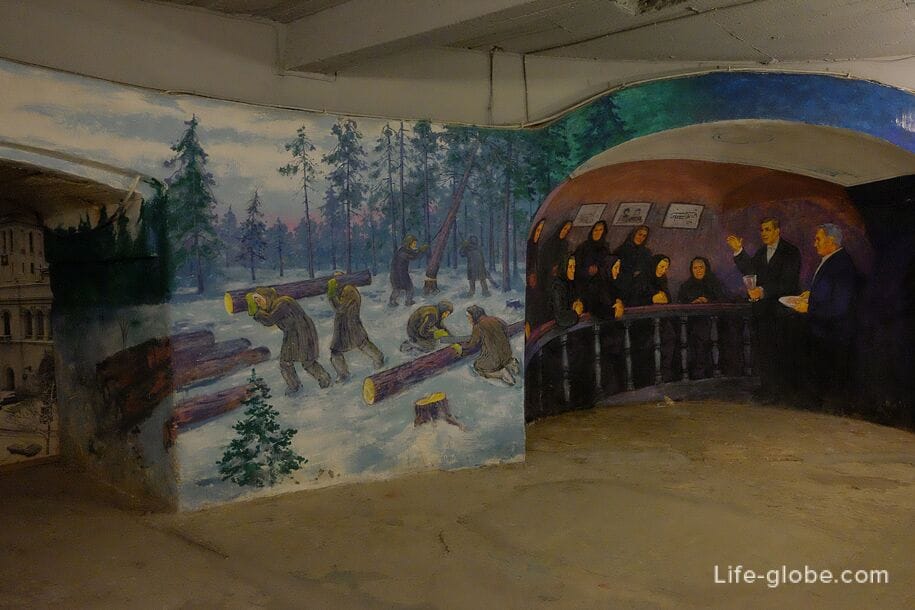
Ensemble of the Church of Saints Peter and Paul
The Petrikirche is located in the back of the buildings on Nevsky Prospekt.
From the very beginning, the church was not a single structure, but was part of an ensemble consisting, in addition to the church itself, also of a school and two houses.
In 1735, two one-and-a-half-story wooden houses were built in front of the church, facing the current Nevsky Prospekt. In one house there is a church (the homes of the pastor, cantor and other ministers), in the other-a school.
In 1747-1752, according to the project of the architect I. G. Kempf, new stone buildings were built on the site of wooden houses.
In 1830-1832, the architect E. T. Zollikofer rebuilt both houses in front of the church into symmetrical three-story stone houses in the style of classicism.
In 1910-1911, both buildings were built on two floors. The superstructure was designed by architect W. E. Collins.
Today, these houses are built into a number of other buildings on Nevsky Prospekt, and the Petrikirche, it turns out, is located behind the buildings - in the courtyard. In the houses there are, among other things, commercial premises.
The buildings include: RiverSide Hotel Nevsky with a 24-hour front desk and a shared lounge with a TV, Apartment Nevsky 22 LUX Apart with free Wi-Fi and private parking, Apartment on Nevsky 24 with free Wi-Fi and free toiletries.
The Russian-German Meeting Center at the Petrikirche is located in the building number 22, which conducts German language courses, organizes youth exchanges, vacation programs, summer language camps, etc.
The simple decoration of the facades of the houses with a flat grid of windows includes cornices, rustication, balusters and sandricks of the second floor, as well as rare balconies.
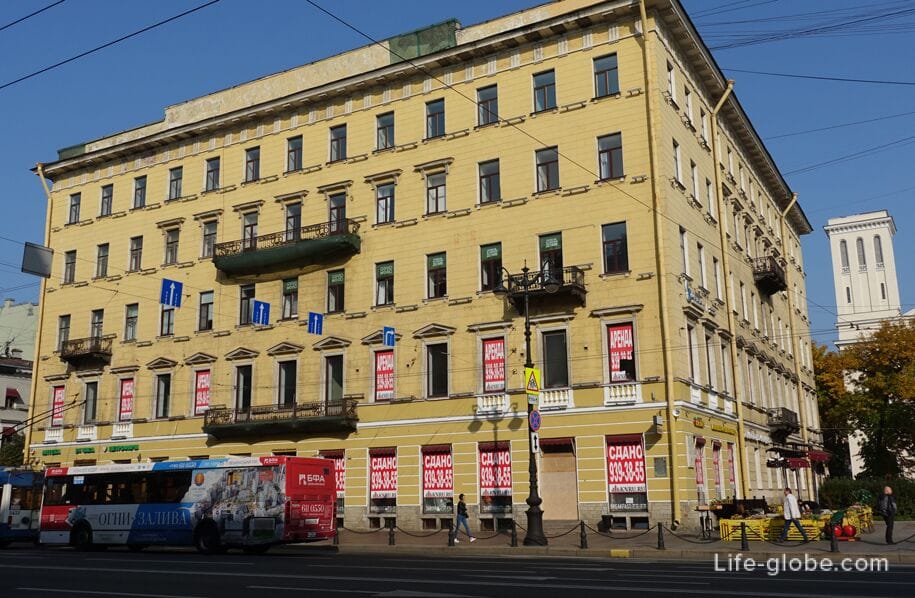

In 1762, on a plot belonging to the Lutheran community, behind the church, a two-story building of the Lutheran school "Petrishule" was built, which later survived many reconstructions, but has survived to this day.
The building still houses the "Petrishule" school, with advanced study of the German language.
The school has a museum of history "Petrishule".
The restored assembly hall of the school is another pride of Petrishule. The hall has excellent acoustics; tiled fireplaces, bronze sconces, chandeliers and floor lamps, which are located on the balcony. In the pre-revolutionary period, the hall was rented for chamber concerts. The composer P. I. Tchaikovsky performed in the hall. Now the hall hosts homecoming evenings and various school-wide events.
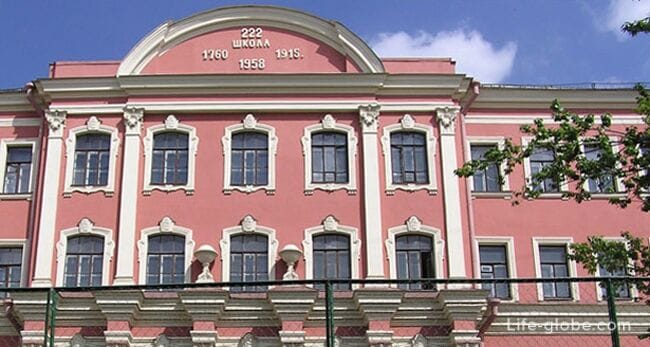
In front of the building of the Petrikirche are:
- bronze bust of Johann Wolfgang von Goethe, by the St. Petersburg sculptor Levon Lazarev, installed on September 30, 1999. The opening of the bust was timed to coincide with the 250th anniversary of the birth of the German poet and thinker. The sculptural portrait is based on Goethe's death mask from the museum in Weimar;
- bronze bust of Johann Sebastian Bach, by the St. Petersburg sculptor Levon Lazarev, installed on September 14, 2019.

Practical information
You can visit the Church of Saints Peter and Paul every day from 9: 00 to 21: 00.
Within the walls of the Petrikirche, various events are regularly held: divine services, concerts, music programs, excursions. The Petrikirche Catacombs host classical organ evenings, symphony concerts and festivals, as well as guided tours and exhibitions of the catacombs.
Address of the Petrikirche: Nevsky Prospekt, 22-24.
Coordinates of Petrikirche: 59°56'12"N 30°19'26"E (59.936667, 30.323889).
Nearest metro stations: "Gostiny Dvor", "Nevsky Prospekt" and "Admiralteiskaya".
Petrikirche website: petrikirche.
Website of the Russian-German Meeting Center: drb. spb.
Petrishule school website: petrishule.spb.
All accommodation facilities in St. Petersburg, including in the city center and on Nevsky Prospekt, can be viewed and booked here




